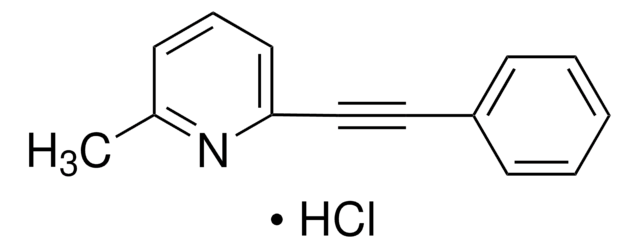M-138
Mephedrone hydrochloride solution
1.0 mg/mL in methanol (as free base), ampule of 1 mL, certified reference material, Cerilliant®
About This Item
Recommended Products
grade
certified reference material
form
liquid
feature
Snap-N-Spike®/Snap-N-Shoot®
packaging
ampule of 1 mL
manufacturer/tradename
Cerilliant®
drug control
Narcotic Licence Schedule D (Switzerland); psicótropo (Spain); Decreto Lei 15/93: Tabela IIA (Portugal)
concentration
1.0 mg/mL in methanol (as free base)
technique(s)
gas chromatography (GC): suitable
liquid chromatography (LC): suitable
application(s)
forensics and toxicology
format
single component solution
storage temp.
−20°C
InChI
1S/C11H15NO.ClH/c1-8-4-6-10(7-5-8)11(13)9(2)12-3;/h4-7,9,12H,1-3H3;1H
InChI key
DLQZFTUKJGRPLZ-UHFFFAOYSA-N
General description
Application
- Nanotube-based Sensors for Drug Molecule Discrimination: Mephedrone is studied for its interaction with nanotube-based sensors, enhancing the discrimination of drug molecules. This research is critical for developing new technologies in forensic science and drug abuse monitoring, providing high accuracy in identifying psychoactive substances (Algharagholy et al., 2023).
- Environmental Monitoring of New Psychoactive Substances: Analytical methods including mephedrone have been developed for the simultaneous determination of 56 new psychoactive substances in surface water. This application is vital for environmental monitoring and understanding the ecological impact of synthetic cathinones, ensuring water safety and public health (Atasoy Aydin et al., 2023).
- Supramolecular Hosts for In Vivo Sequestration: Research on supramolecular hosts capable of sequestering mephedrone and other stimulants like methamphetamine and fentanyl in vivo, provides significant advancements in therapeutic approaches for drug addiction and overdose treatment. This study paves the way for novel detoxification strategies using chemical sequestrants (Brockett et al., 2023).
- SERS Substrates for Clinical Applications: Mephedrone has been examined in the development of ultrasensitive portable Surface-Enhanced Raman Scattering (SERS) substrates. These substrates are designed for rapid and precise clinical diagnostics, showcasing the potential of mephedrone in enhancing bioanalytical methods (Lin et al., 2023).
- Forensic Differentiation of Isomers: Portable near-infrared spectroscopy has been utilized for the isomeric differentiation of mephedrone among new psychoactive substances. This technology is essential for law enforcement and forensic applications, providing a quick and non-destructive means to distinguish between drug isomers in field conditions (Kranenburg et al., 2022).
Legal Information
Signal Word
Danger
Hazard Statements
Precautionary Statements
Hazard Classifications
Acute Tox. 3 Dermal - Acute Tox. 3 Inhalation - Acute Tox. 3 Oral - Flam. Liq. 2 - STOT SE 1
Storage Class Code
3 - Flammable liquids
WGK
WGK 1
Flash Point(F)
49.5 °F - closed cup
Flash Point(C)
9.7 °C - closed cup
Certificates of Analysis (COA)
Search for Certificates of Analysis (COA) by entering the products Lot/Batch Number. Lot and Batch Numbers can be found on a product’s label following the words ‘Lot’ or ‘Batch’.
Already Own This Product?
Find documentation for the products that you have recently purchased in the Document Library.
Articles
As new “bath salt” drugs such as methylone, ethylone, mephedrone, butylone and other methcathinone analogs increase in popularity, toxicologists require native and labeled certified reference materials to accurately identify and quantify the new compounds in patient samples.
The combination of ion-exchange SPE with the HILIC HPLC separation provides a novel approach for the testing of problematic bath salt compounds.
Separation of Butylone hydrochloride solution, 1.0 mg/mL in methanol (as free base), ampule of 1 mL, certified reference material; Ethylone hydrochloride, 1.0 mg/mL in methanol (as free base), ampule of 1 mL, certified reference material; Mephedrone hydrochloride solution, 1.0 mg/mL in methanol (as free base), ampule of 1 mL, certified reference material; Methedrone hydrochloride solution, 1.0 mg/mL in methanol (as free base), ampule of 1 mL, certified reference material; Methylone hydrochloride, 1.0 mg/mL in methanol (as free base), ampule of 1 mL, certified reference material
LC-MS/MS is a powerful tool that brings numerous benefits to the clinical sample analysis arena. However, due to the complexity of the instrumentation there are some unique challenges that also accompany these benefits. Even following sample extraction and cleanup, matrix effects from the samples can cause interferences or impact ionization efficiency.
Protocols
Separation of 3,4-Methylenedioxypyrovalerone HCl (MDPV) solution, 1.0 mg/mL in methanol (as free base), ampule of 1 mL, certified reference material; Buphedrone hydrochloride solution, 1.0 mg/mL in methanol (as free base), ampule of 1 mL, certified reference material; 3-Fluoromethcathinone hydrochloride solution, 1.0 mg/mL in methanol (as free base), ampule of 1 mL, certified reference material; Butylone hydrochloride solution, 1.0 mg/mL in methanol (as free base), ampule of 1 mL, certified reference material; Ethylone hydrochloride, 1.0 mg/mL in methanol (as free base), ampule of 1 mL, certified reference material; 4-Fluoromethcathinone hydrochloride solution, 1.0 mg/mL in methanol (as free base), ampule of 1 mL, certified reference material; Mephedrone hydrochloride solution, 1.0 mg/mL in methanol (as free base), ampule of 1 mL, certified reference material; Methylone hydrochloride, 1.0 mg/mL in methanol (as free base), ampule of 1 mL, certified reference material; Methedrone hydrochloride solution, 1.0 mg/mL in methanol (as free base), ampule of 1 mL, certified reference material
Our team of scientists has experience in all areas of research including Life Science, Material Science, Chemical Synthesis, Chromatography, Analytical and many others.
Contact Technical Service


